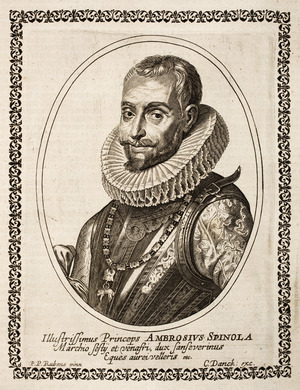Ambrogio Spinola facts for kids
Quick facts for kids
The Most Excellent
The Marquess of Balbases
|
|
|---|---|
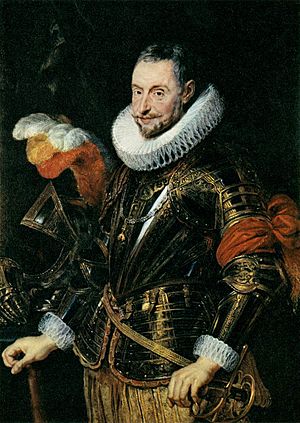
Portrait by Peter Paul Rubens (1627)
|
|
| Governor of the Duchy of Milan | |
| In office 1629–1630 |
|
| Monarch | Philip IV of Spain |
| Preceded by | Gonzalo Fernandez de Córdoba |
| Succeeded by | Álvaro de Bazán |
| Personal details | |
| Born | 1569 Genoa, Republic of Genoa |
| Died | 25 September 1630 (aged 60–61) Castelnuovo Scrivia, Duchy of Mantua |
| Signature | |
| Military service | |
| Allegiance | |
| Rank | Captain-General |
| Commands | Captain-General of the Army of Flanders |
| Battles/wars | |
Ambrogio Spinola Doria (1569 – 25 September 1630) was an Italian nobleman and military leader. He became a famous general for Spain, winning many important battles. People often call him "Ambrosio." He is known as one of the greatest military commanders of his time. His victories earned him the title of Marquess of Los Balbases in Spain. He also received special honors like the Order of the Golden Fleece.
Contents
Ambrogio Spinola's Early Life
Ambrogio Spinola was born in Genoa, Italy, in 1569. His family, the Spinolas, was very old, rich, and powerful in Genoa. His father was Filippo Spinola, and his mother was Polissena Grimaldi.
In the 1500s, the Republic of Genoa was closely connected to the Spanish Empire. Genoese families like the Spinolas often helped manage Spain's money. Ambrogio's younger brother, Federico, became a soldier in the Spanish army. Ambrogio, as the oldest son, stayed in Genoa to continue the family name. In 1592, he married Giovanna Bacciadonne.
Serving the Spanish King
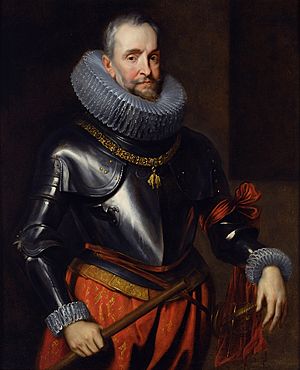
The Spinola family had a rivalry with another powerful family in Genoa, the Dorias. Ambrogio Spinola decided to leave Genoa and use his family's wealth to serve the Spanish king in Flanders. In 1602, he and his brother Federico made a deal with the Spanish government. They would raise soldiers and ships for Spain. This was a huge risk for Ambrogio, as he used his family's entire fortune.
Federico's ships were attacked by English and Dutch warships. He was killed in battle in 1603. Ambrogio, however, marched his 9,000 soldiers to Flanders. He had paid for these soldiers himself. His first real experience as a general began when he took over the Siege of Ostend in 1603. Ostend was a city that had been under siege for a long time. Ambrogio successfully captured it in 1604. This victory made him very famous and earned him the Order of the Golden Fleece.
War in the Low Countries
After his success at Ostend, Ambrogio Spinola became the commander-in-chief in Flanders. Wars in the Low Countries (modern-day Belgium and Netherlands) often involved sieges. Spinola became known for capturing many towns, even when Maurice of Nassau tried to stop him. One of his famous captures was the heavily fortified town of Groenlo.
Spinola continued to serve Spain, but his family's money was running out. He had to promise his entire fortune to help pay for the war. Sadly, he was never repaid, which led to his family's financial ruin. Despite this, he continued to lead the Spanish army successfully until a peace agreement, the Twelve Years' Truce, was signed in 1609.
In 1614, he was involved in operations around Kleve and Jülich. From 1620 to 1622, during the Thirty Years' War, he led a campaign in the Lower Palatinate. He captured many towns and was promoted to Captain-General.
The Famous Siege of Breda
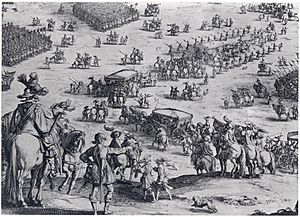
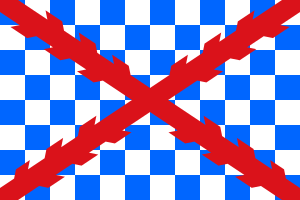
Ambrogio Spinola's most famous victory was the capture of Breda. This siege lasted a long time, from August 1624 to June 1625. Even the Spanish king, Philip IV of Spain, thought it was too risky. But Spinola succeeded, despite efforts by Maurice of Nassau to save the city.
After Breda surrendered, Spinola showed great kindness. He allowed the defeated soldiers to leave the city with their flags and weapons. This was seen as a very noble act across Europe. Spinola famously said, "The valor of the defeated is the glory of the victor." This moment is shown in the famous painting Las Lanzas by Diego Velázquez.
The capture of Breda was the peak of Spinola's career. However, Spain was running out of money, and a powerful minister named Olivares was jealous of Spinola. Spinola could not stop Frederick Henry of Nassau from taking Groll (or Groenlo) in 1627. In 1628, Spinola went back to Spain. He refused to lead the army in Flanders again unless he was guaranteed support.
Death of a General
Spain then started another war over who would rule the Duchy of Mantua. Spinola was sent to Italy as a general. He arrived in Genoa in September 1629. The famous painter Diego Velázquez traveled with him to see famous artworks in Italy.
Even in Italy, Spinola faced problems from Olivares, who took away some of his powers. Spinola was already 61 years old and had spent over 30 years fighting. His health began to fail. He died on September 25, 1630, during the Siege of Casale. It is said that his last words were "honor" and "reputation."
His family never got back the huge fortune they spent serving the Spanish kings. However, King Philip IV ordered Diego Velázquez to paint Spinola in The Surrender of Breda in 1635, honoring his great victory.
Spinola was a brilliant military leader. He was known for his daring moves in battle, often surprising his enemies. He was a master of military skills, using quick movements to find and attack his enemy's weakest points.
Family Life
Ambrogio Spinola and Giovanna Bacciadonne had three children:
- Filippo (1594–1659), who became the 2nd Marquess of Balbases after his father.
- Polissena (died 1639), who married Diego Felipe de Guzmán, who was also a Governor of Flanders.
- Agustin (1597–1649), who became a bishop and later an archbishop.
|
Sources
- Instituto de Salazar y Castro (in es). Elenco de Grandezas y Titulos Nobiliarios Españoles. periodic publication.
- Rodriguez Villa, A. (1905) (in es). Ambrosio Spinola, primer marqués de Los Balbases. Madrid, Spain. https://archive.org/details/ambrosiospnolap00villgoog.
- Genealogía de la familia y del apellido Spinola (in Spanish)
| Government offices | ||
|---|---|---|
| Preceded by Gonzalo Fernández de Córdoba |
Governor of the Duchy of Milan 1629–1630 |
Succeeded by Álvaro de Bazán |
| Italian nobility | ||
| New title | Duke of Sesto 1612–1630 |
Succeeded by Filippo Spínola |
| Spanish nobility | ||
| New title | Marquess of Los Balbases 1621–1630 |
Succeeded by Filippo Spínola |
See also
 In Spanish: Ambrosio Spínola para niños
In Spanish: Ambrosio Spínola para niños


